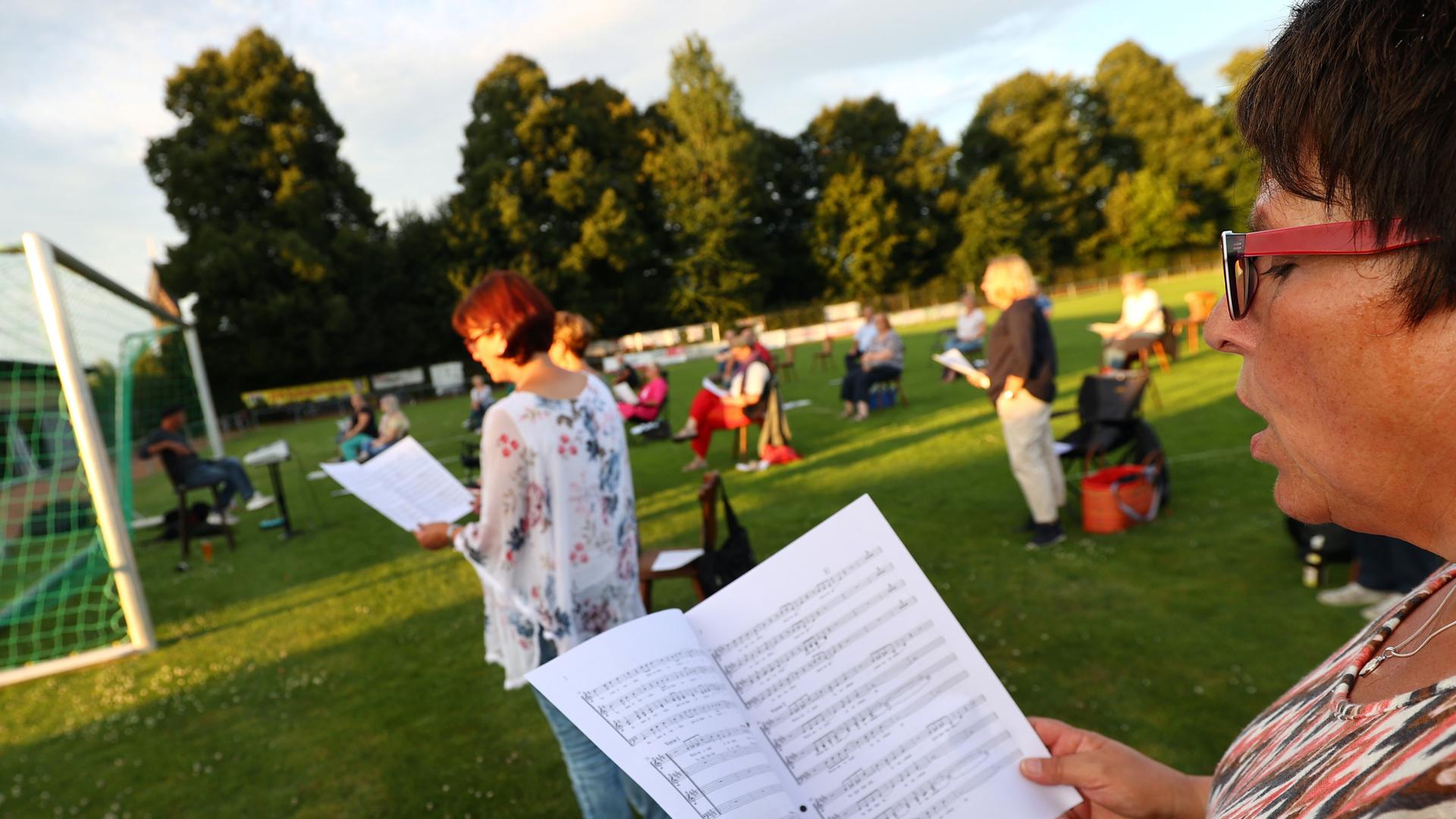Members of the local choir “Ton in Ton” (Note by Note) sing during the weekly rehearsal under restrictions due to the outbreak of the coronavirus disease (COVID-19) at a soccer pitch in Hanau near Frankfurt, Germany, July 27, 2020.
You may recall reports of a cluster of cases of the coronavirus that was traced to a choir rehearsal back in the spring. More than 50 members of the Skagit Valley Chorale, in Mount Vernon, Washington, were infected in what the CDC called a “superspreader event.”
Two people died.
Related: Why coronavirus tests differ around the world
It was the first account — but not the last — linking community transmission of the coronavirus with singing.
On July 9, the World Health Organization confirmed “evidence that COVID-19 might be spread by tiny particles of moisture that can hang in the air in enclosed or unventilated spaces,” after 200 scientists warned that airborne transmission may be underestimated, according to the BBC.
While most experts agree that singing in a group is risky, no studies have attempted to measure that risk scientifically — until now.
Jonathan Reid is a professor of chemistry who is leading a research team at Bristol University in the UK, looking into virus transmission and singing. He spoke to The World’s Marco Werman about why it’s important to know how many particles a person sprays while singing compared to regular talking — and what that might mean for the future of choirs in the age of the coronavirus.
Related: Artists flock to the only ‘festival’ still on during COVID-19
Marco Werman: First of all, many of us may not imagine singing to be a lethal activity. So, how serious is this — the transmission of the virus through singing?
Jonathan Reid: It’s very difficult to answer that question at the moment. The studies just have not been done and that’s really where our study comes in. So far, studies have focused on, for example, on speaking and looking at how the number of particles — these very small aerosol particles that you generate — how they increase as you speak louder. But we just don’t know the answer to that for singing. And we certainly don’t know how many particles you generate when you sing compared to when you speak. And that’s really what we’re trying to assess in this study.
Related: This Spanish trio makes socially conscious music under lockdown
What have you been measuring? And how have you been doing it?
We’ve had to do these measurements in an orthopedic operating theater, which has very, very clean air so we can be certain that every particle we measure actually comes from the performer, whether they’re singing or speaking.
The singing is done through a funnel. Why is that?
The funnel is our sampling device. It is the way we sample the aerosol from someone singing into the very sensitive instruments that we have to count the number of particles that they’re generating when they sing.
Why pick the song “Happy Birthday” for this test?
We’ve picked that song just because it can be recited by singers and by instrumentalists and for performance for singers. It has a range of consonants and vowels, which are particularly helpful. So, we asked them to sing “Happy Birthday” to “Susan.” And so, they sing that repeatedly. We look at how the aerosol they generate varies as they sing at different volumes. And, you know, it provides a very good comparison across our large cohort of participants.
How big is this study and how do you select your subjects?
We have participants from across a broad range of genres, from opera through to soul, gospel, jazz, pop, musical theater. And in terms of instruments, woodwind and brass, we studied 12 instruments from flute, piccolo, bassoon, fruit, trumpet, trombone and tuba.
In the case of the chorale in Washington state, with 61 people there, more than 50 got sick — apparently, a lot of people attending were aware of what they had to do to stay safe. How does singing compare with other activities in which people congregate, even when those people are conscious of best health practices?
I think it’s very hard retrospectively to definitively identify the mode of transmission. I mean, I think the study that you’re describing actually does make a very strong case for airborne transmission, partly because of the large number of people that are infected and just the implausibility of people actually coming into contact with that number of participants within the timeframe of the rehearsal. So when we’re concerned with airborne transmission, physical distancing doesn’t really help. It’s really about how well-ventilated a room is, because, as I say, these aerosol particles can remain airborne for many minutes or hours. And so really, they travel distances more than the 1 to 2 meters that we’re all accustomed to in physical distancing.
Have you ever sung in a choir?
I sing a great deal. I usually sing a great deal. And I also play the trumpet. So, I very much am keen to really get to the results of the study as soon as we can as well because, like many amateur performers, I am missing that opportunity to participate in music.
This interview has been edited and condensed for clarity.
We’d love to hear your thoughts on The World. Please take our 5-min. survey.
